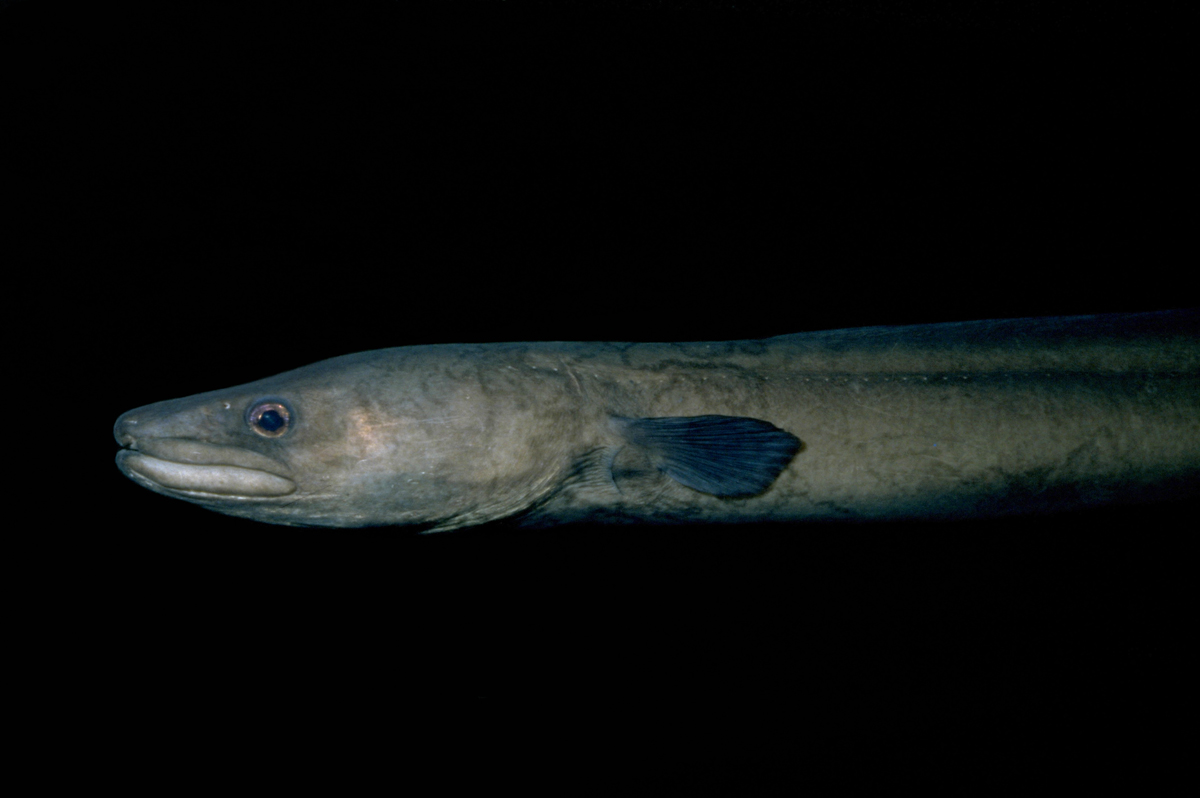Southern Conger, Conger verreauxi Kaup 1856
Other Names: Common Conger-eel, Conger Eel, Short-finned Conger-eel, Southern Conger Eel, Southern Conger-eel

A Southern Conger, Conger verreauxi. Source: Rudie H. Kuiter / Aquatic Photographics. License: All rights reserved
Summary:
A dark greyish to bluish-black eel that is paler below on the jaws, throat and trunk and extensively in smaller specimens. Juveniles have a narrow black margin on the dorsal and anal fins.
The Southern Conger has often been confused with the closely related but more slender and small-eyed Conger on eastern and western coasts of Australia. This species has long been known as Conger “wilsoni”, a name that was intended for a moray eel. The correct name for this second species is yet to be determined.
Video of a Southern Conger at Woodbridge, Tasmania.
A Southern Conger taking the bait at Woodbridge, Tasmania.
The Southern Conger has often been confused with the closely related but more slender and small-eyed Conger on eastern and western coasts of Australia. This species has long been known as Conger “wilsoni”, a name that was intended for a moray eel. The correct name for this second species is yet to be determined.
Video of a Southern Conger at Woodbridge, Tasmania.
A Southern Conger taking the bait at Woodbridge, Tasmania.
Cite this page as:
Bray, D.J. 2022, Conger verreauxi in Fishes of Australia, accessed 10 Jul 2025, https://fishesofaustralia.net.au/Home/species/3442
Southern Conger, Conger verreauxi Kaup 1856
More Info
|
Distribution |
SE of Yamba, New South Wales, to Kangaroo Island, South Australia, including Tasmania; also Lord Howe Island in the Tasman Sea. Elsewhere, the species occurs in New Zealand, particularly in the South Island. Usually inhabits rocky areas and crevices inshore, but sometimes occurs in deeper waters. A nocturnal predator that usually shelters in caves, holes and crevices during the day. |
|
Features |
Dorsal fin 331–347; Anal fin 238–265; Caudal fin 9; Pectoral fin 17–18; Lateral line (pores) 40–44 (to anus); Vertebrae 157–165. Body depth about 8 % TL; head length about 14 % TL; eye 1.2–1.9% TL); dorsal-fin origin above the tip of the pectoral-fin. |
|
Size |
Reaches 20 cm TL and 20 kg. |
|
Feeding |
Actively forages at night, feeding on fishes, crustaceans and cephalopod molluscs. |
|
Similar Species |
The Eastern Conger, Conger "wilsoni", in has the dorsal-fin origin slightly behind the pectoral-fin tip (vs above the pectoral-fin tip in the Southern Conger). In addition, the Eastern Conger is more slender, has a smaller eye, and differs in number of vertebrae, lateral line pores and dorsal-fin rays. |
|
Etymology |
The species is named for French botanist, Julius Verreaux, the author's “honorable friend”. |
|
Species Citation |
Conger verreauxi Kaup, 1856, Arch. Naturg. 22(1): 72. Type locality: "Australia". |
|
Author |
Bray, D.J. 2022 |
|
Resources |
Southern Conger, Conger verreauxi Kaup 1856
References
Castle, P.H.J. 1994. Families Serrivomeridae, Muraenidae, Nemichthyidae, Congridae. pp. 205-215 figs 182-191 in Gomon, M.F., Glover, C.J.M. & Kuiter, R.H. (eds). The Fishes of Australia's South Coast. Adelaide : State Printer 992 pp. 810 figs.
Edgar, G.J., Last, P.R. & Wells, M.W. 1982. Coastal Fishes of Tasmania and Bass Strait. Hobart : Cat & Fiddle Press 175 pp.
Hutchins, J.B. & Swainston, R. 1986. Sea Fishes of Southern Australia. Complete field guide for anglers and divers. Perth : Swainston Publishing 180 pp.
Kaup, J.J. 1856. Uebersicht der Aale. Archiv für Naturgeschichte 22(1): 41-77. See ref at BHL
Kuiter, R.H. 1993. Coastal Fishes of South-eastern Australia. Bathurst : Crawford House Press 437 pp.
Smith, D.G. 2008. Family Congridae. pp. 174-179, in Gomon. M.F., Bray, D.J. & Kuiter, R.H (eds). Fishes of Australia's Southern Coast. Sydney : Reed New Holland 928 pp.
Smith, D.G. & Stewart, A.L. 2015. Families Derichthyidae, Nemichthyidae, Congridae, Nettastomatidae, Serrivomeridae. pp. 259-290 in Roberts, C.D., Stewart, A.L. & Struthers, C.D. The Fishes of New Zealand. Wellington : Te Papa Press Vol. 2 pp. 1-576.



